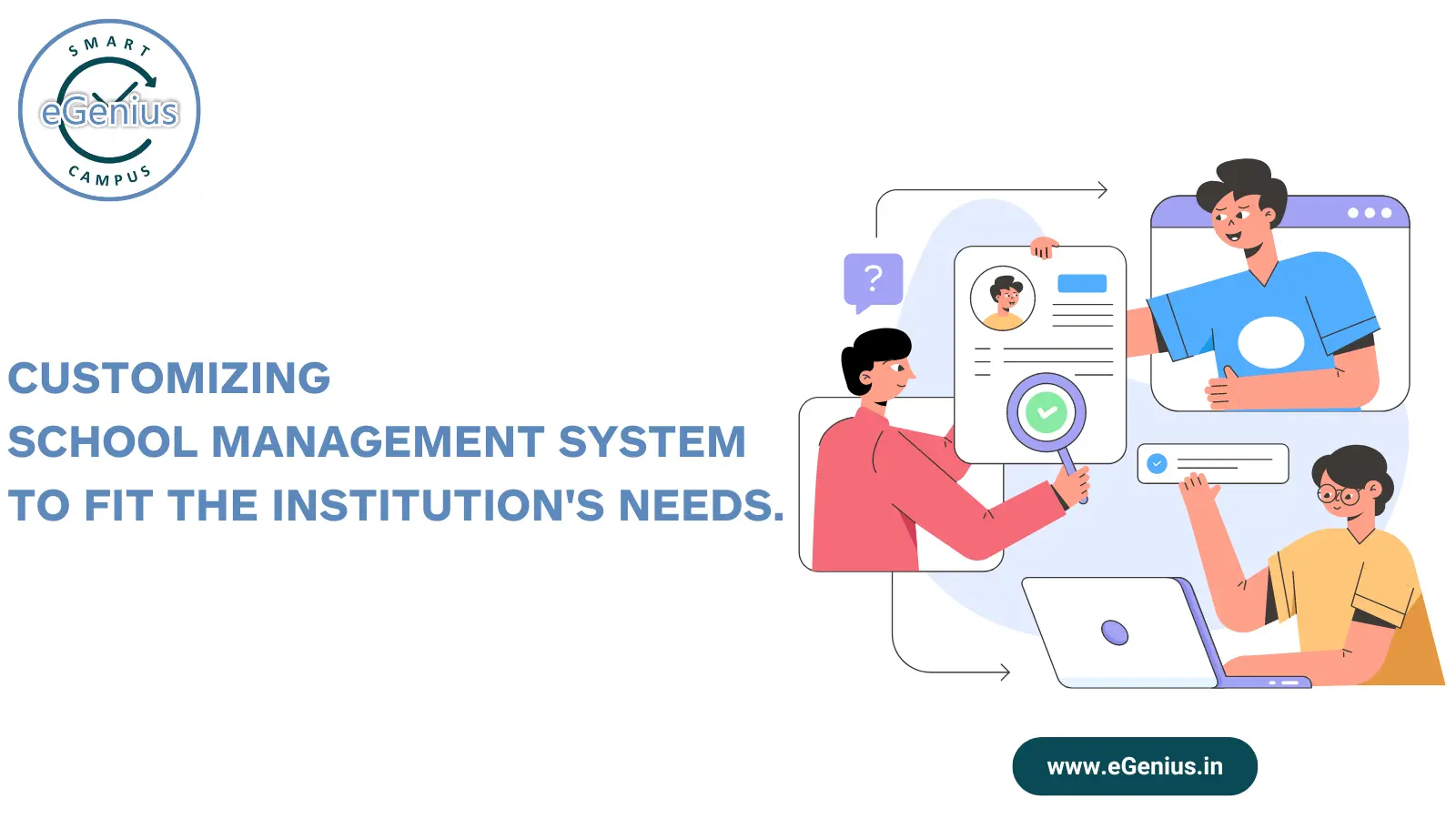In today’s fast-paced educational environment, a robust School Management System is essential for efficient administration and enhanced learning experiences. However, each educational institution has unique needs that must be met to ensure the system’s effectiveness. Customizing School Management Software to fit these specific requirements can make a significant difference in achieving the desired outcomes. This blog will guide you through the process of tailoring a School ERP to align with your institution’s needs, from assessing requirements to evaluating and updating the system.
Tabel of Content
- Assessing Institution’s Unique Requirements
- Choosing the Right School Management System and Vendor
- Key Areas of Customization in School Management System
- Implementation and Training of School Management System
- Evaluating and Updating the System
Assessing Institution’s Unique Requirements
Before diving into the customization of a School Management System, it is crucial to understand the specific needs of your institution. Here are the steps to follow:
- Stakeholder Analysis: Identify the key stakeholders, including administrators, teachers, students, and parents. Understand their requirements and expectations from the School Management Software.
- Current Process Evaluation: Examine the existing administrative and academic processes. Determine what works well and what needs improvement.
- Gap Analysis: Compare current processes with desired outcomes. Identify gaps that a School ERP can bridge.
- Prioritize Needs: Rank the identified needs based on their impact on efficiency and learning outcomes. Focus on high-priority areas for customization.
- Future-Proofing: Consider potential growth and changes in the institution. Ensure that the system can adapt to future needs and technological advancements.
Choosing the Right School Management System and Vendor
Selecting the right School Management Software and vendor is a critical step. Here’s how to approach it:
- Market Research: Conduct thorough research on available School Management System. Compare features, scalability, and user reviews.
- Vendor Credibility: Assess the reputation and experience of potential vendors. Look for those with a proven track record in the education sector.
- Feature Match: Ensure the system offers essential features such as attendance tracking, grade management, communication tools, and reporting capabilities.
- Customization Options: Verify that the vendor provides customization services. The system should be flexible enough to tailor to your institution’s unique needs.
- Support and Training: Evaluate the vendor’s support and training offerings. Adequate training ensures smooth implementation and effective use of the system.
- Cost Analysis: Compare the costs of different systems and vendors. Consider both initial and ongoing costs, ensuring they fit within your budget.
Key Areas of Customization in School Management System
Customization of School Management Software involves several key areas. Here’s a breakdown of what to focus on:
- User Interface: Customize the interface to match the institution’s branding and make it user-friendly for all stakeholders.
- Modules and Features: Tailor specific modules such as admissions, attendance, and grading to meet your institution’s processes.
- Workflow Automation: Automate repetitive tasks such as fee processing, report generation, and notifications to save time and reduce errors.
- Communication Tools: Integrate communication features to facilitate seamless interaction between teachers, students, and parents.
- Reporting and Analytics: Customize reporting tools to provide insights into academic performance, attendance trends, and administrative efficiency.
- Integration with Existing Systems: Ensure the new system integrates smoothly with other tools and platforms already in use at the institution.
- Security Features: Customize security settings to protect sensitive data and comply with relevant regulations.
Implementation and Training of School Management System
Successful implementation and training are vital for the effective use of customized School Management Software. Follow these steps:
- Implementation Plan: Develop a detailed implementation plan outlining the timeline, responsibilities, and milestones.
- Data Migration: Ensure smooth migration of existing data into the new system. Validate the accuracy and completeness of migrated data.
- Pilot Testing: Conduct pilot testing with a small group of users to identify issues and gather feedback before full-scale deployment.
- Training Programs: Organize comprehensive training sessions for all users. Provide manuals, tutorials, and ongoing support to ensure proficiency.
- Feedback Mechanism: Establish a feedback mechanism to address user concerns and improve the system based on user experiences.
- Go-Live Support: Offer additional support during the initial phase after the system goes live to resolve any immediate issues.
Evaluating and Updating the System
Regular evaluation and updates are essential to maintain the efficiency of a School Management Software. Here’s how to proceed:
- Performance Monitoring: Continuously monitor the system’s performance to ensure it meets the institution’s needs.
- User Feedback: Collect regular feedback from users to identify areas for improvement and address any emerging issues.
- System Updates: Keep the system updated with the latest features and security patches provided by the vendor.
- Periodic Reviews: Conduct periodic reviews to assess the system’s effectiveness and alignment with institutional goals.
- Scalability Checks: Ensure the system can scale with the institution’s growth and changing requirements.
- Continuous Improvement: Implement a continuous improvement process to adapt the system to evolving needs and technological advancements.
Customization feature in the eGenius School Management System to fit an institution’s unique needs is a comprehensive process that requires careful planning and execution. By assessing specific requirements, choosing the right system and vendor, focusing on key customization areas, ensuring proper implementation and training, and regularly evaluating and updating the system, institutions can significantly enhance their administrative efficiency and educational outcomes. A well-customized School Management System streamlines operations and supports the educational institution’s overall growth and success.
Know more about School Management System.














